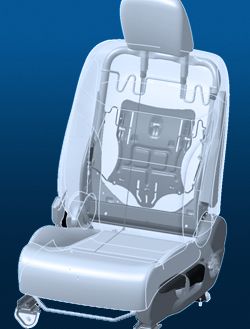
The driver and front-passenger seats in the ’12 Honda Civic compact sedan and coupe are redesigned for the new model, alleviating whiplash in rear collisions more effectively than the ones they replace, Honda says.
“With a rear collision in a conventional system, the headrest moves forward to support your neck,” ninth-generation Civic chief engineer Mitsuru Horikoshi tells Ward’s in a recent interview, via a translator.
“This time, the headrest doesn’t move. The person in a rear crash moves back and sinks into the seat. So in that sense, the concept is very different.”
The previous-generation Civic, sold from the ’06-’11 model years in the U.S., was equipped with a conventional active headrest design, which in a rear crash pushed the headrest up and forward, propelled by a mechanism in the seatback, to mitigate neck stress.
Horikoshi says this solution was “not efficient. We wanted to come up with something that was lighter.”
Thanks to the new redesign, the latest seatback not only is safer but also weighs 13% less than the one it replaces and has 20% fewer parts, helping Honda take weight out of the car and improve fuel economy, as well.
Innovations in spring- and cushion-tuning in the new front seatbacks, co-developed with Honda’s longtime interior-supplier TS Tech, allow the seatback to envelop the driver and front passenger to a greater degree during a rear collision.
These innovations include:

- Vertical grooves in the urethane foam.
- Wavy, or folded, cushion springs.
- Rotating mechanisms in the cushion springs that connect to and control the position of the resin plate in the seatback.
“Normally, it might be a straight connection,” Horikoshi says of the new wavy springs. “That’s difficult. It doesn’t deflect very well. So by adding a wave, a curve to it, it makes it easy for it to deform or deflect.”
The rotating mechanisms, one near each side at the bottom of the seatback, rotate in and back so an occupant can sink further into the seat and closer to the headrest.
Horikoshi says the changes made to the’12 Civic front seatbacks should be imperceptible to their occupants under ordinary driving conditions.
“When you’re normally sitting in the seat, it’s like it is (in the outgoing model),” he says of comfort levels.
While the Civic is the first Honda, or Acura, model to use the new, softer seatbacks in lieu of movable headrests, it won’t be the last. American Honda spokesman Chris Martin discloses the new neck-impact mitigation seats will be found in unnamed, upcoming models.
Select grades of the new ’12 Civic are on sale now in the U.S.



